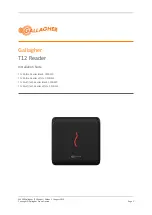
Chapter 6
94
Counter/Timer Features
The counter/timer circuitry on the board provides the clocking circuitry used by the A/D
subsystem as well as several user counter/timer features. This section describes the following
user counter/timer features:
• Counter/timer channels
• C/T clock sources
• Gate types
• Pulse types and duty cycles
• Counter/timer operation modes
Counter/Timer Channels
The DT300 Series board supports four user 16-bit counter/timer channels (called counters);
counters are numbered 0, 1, 2, and 3.
Each counter accepts a clock input signal and gate input signal and outputs a clock output
signal (also called a pulse output signal), as shown in
Figure 31: Counter/Timer Channel
Each counter corresponds to a counter/timer (C/T) subsystem. To specify the counter to use
in software, specify the appropriate C/T subsystem. For example, counter 0 corresponds to
C/T subsystem element 0; counter 3 corresponds to C/T subsystem element 3.
Using software, you can internally route the clock output signal from one user counter to the
clock input signal of the next user counter to internally cascade the counters. In this way, you
can create a 32-bit counter without externally connecting two counters together.
Clock Input SIgnal
(internal, external, or
internally cascaded)
Counter
Gate Input Signal
(software or external
input)
Pulse Output Signal
Summary of Contents for DT300 Series
Page 1: ...DT300 Series UM 16501 T User s Manual Title Page ...
Page 4: ......
Page 10: ...Contents 10 ...
Page 14: ...About this Manual 14 ...
Page 15: ...15 1 Overview Features 16 Supported Software 18 Accessories 19 Getting Started Procedure 20 ...
Page 21: ...Part 1 Getting Started ...
Page 22: ......
Page 58: ...Chapter 4 58 ...
Page 69: ...Part 2 Using Your Board ...
Page 70: ......
Page 106: ...Chapter 6 106 ...
Page 124: ...Chapter 8 124 ...
Page 130: ...Chapter 9 130 ...
Page 156: ...Appendix C 156 ...
Page 164: ...Index 164 ...
















































